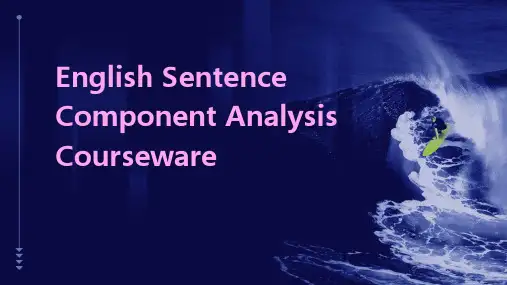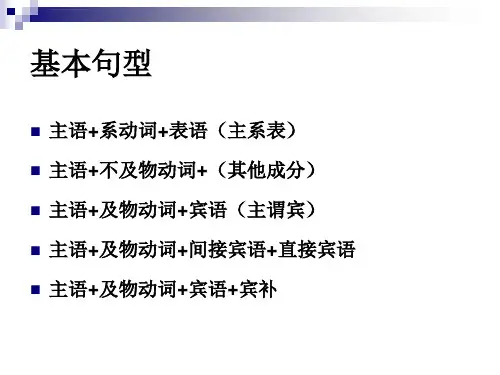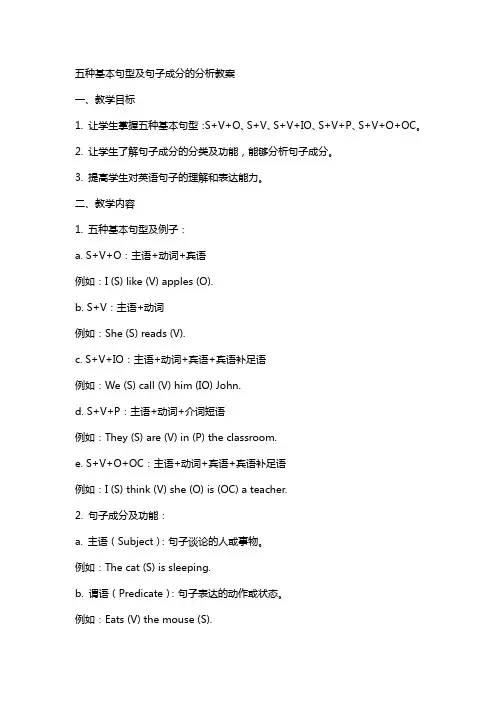英语句子成分分析复习课程
英语句子成分划分详解公开课一等奖优质课大赛微课获奖课件

我们为人
• What happened? 事?
发生了什么
• He worked hard all day today. 他今天 苦干了一天。
• The plane took off at ten o’clock. 飞机是
十点起飞。
第7页
2),复合谓语:情态动词+不定式
• I can speak a little English. 我 能够说一点英语。
第14页
1.副词最惯用作状语,位置比较灵活, 可置句末、句首和句中。
• He speaks the language badly but read it well.
• 这种语言,他讲得不好,但阅读能力很强。 • Naturally we expect hotel guests
to lock their doors. • 当我们盼望旅馆旅客把房门锁上。
第19页
• 1.形容词用作定语是大量。
• She is a natural musician. 乐家。
她是一位天生音
• He must be the best violinist alive. 他一定是最 好在世小提琴手了。(后置定语)
• 2. 名词用作定语。
• A baby girl 女婴
• well water 井水
他上个星期离开了那
• 5.由不定式构成
• Does she really mean to leave home? 她真要
离开家吗?
第13页
5. 状语
• 状语用来修饰动词、形容词、副词以及全 句句子成份。普通表示行为发生时间、地 点、目的、方式、程度等意义,普通由副 词、介词短语、不定式或相称于副词词或 短语来表示。状语普通放在句末,但有能 够放在句首、句中。可用作状语有副词、 代词、数词、形容词、不定式、分词、介 词短语、从句等。
2024届高考英语复习:句子成分课件(共74张PPT)

试卷讲评课件
例如: I happened to meet him on my way back. 我在回家的路上碰巧遇见了他。(半助动词+不定式) Passengers may not take any photo during flight. 飞行期间,旅客不得拍照。(情态动词+动词原形)
She was determined to find out who was responsible for this. 她决意弄清楚谁该对此事负责。(be+形容词+不定式) She is known to be a good teacher. 大家都称她是一位优秀教师。(动词被动式+不定式)
二、复合谓语
试卷讲评课件
复合谓语有多种结构,包括: 半助动词+不定式( appear to do, seem to do, happen to do 等); 情态动词+动词原形; be+形容词+不定式(be about to do , be determined to do, be ready to do 等); 动词被动式+不定式/现在分词/过去分词(be known to be, be found to do, be kept doing 等); used to+动词; 连系动词+表语。
Point 2、 谓语 谓语说明主语的动作或状态,也是句子的主体部分,通常由动词或短语动 词充当。谓语有人称和数的变化,可分为简单谓语和复合谓语两类。
一、简单谓语
试卷讲评课件
由一个动词或短语动词构成。 例如: The car parks operate a pay-as-you-leave system. 这些停车场按“离开时付费”的模式运作。(实义动词) Don't take on too much work-the extra cash isn't worth it. 不要太卖命了--多挣那点钱不值得。(动词短语)
英语句子成分分析课件

A noun or pronoun that functions as a completion to a verb or position, modifying or describing the subject or object
Attribute
"The book" in the presence "John likes the book."
Example
Predict
The action or state described in the presence, commonly consistent of a verb and its completeness
Example
"reads" in the presence "John reads books."
contents
目录
Translation Techniques for Sentence ElementsPractice and consolidation
01
Introduction
To improve the ability to analyze and compose English sentences
Definition
A clause that belongs to the main clause, usually guided by subordinate conjunctions such as when, because, if, etc.
Analysis
In this sentence, "when the rain stops" is a subordinate clause that modifies the main sentence "I will go to the park".
句子成分和句子结构(31张PPT)初中英语专项复习课件

AB C
D
③ She find it difficult to do the work.
ABC
D
④ They call me Lily sometimes.
AB C
D
⑤ I saw Mr. Wang get on the bus.
主 表 宾 定 状 宾补
1) 主语(subject) 句子的主体,全句述说的对象。一般由担任,常置于句首。
名词,主格代词 ,动词不定式,动名词或从句
I like football. The boy needs a pen. 2) 谓语(predicate) 说明主语的动作或状态。由 动词 担任。常置于主语后。 The train leaves at 6 o’clock. I want a ticket.
I am very sorry. We often help him. When I grow up , I am going to be a teacher . (从句作时间状语)
八大句子成分
主语 谓语 宾语 宾语补足语 表语 定语 状语 同位语
十大词类
冠词 名词 代词 数词 形容词 副词 介词短语 动名词 动词不定式 分词
5) 宾补(objective complement) 补充说明宾语的情况 。 由n. /adj. /介宾 /分词 /不定式等担任。 They made him‹king.› I consider the book‹too expensive.›
6) 定语(attributive) 对名词或代词起修饰、限定作用的词、短语或句子, 汉语中常用‘……的’表示,通常位于被修饰的成分前。
这间屋子里的男孩子们是10班的。 The students in the room are in Class Nine.
英语句子成分分析分析解析ppt课件

illness. He always comes late to school.
We elected him monitor. →He was elected monitor.
He pushed the door open. →The door was pushed open.
认识到了贫困户贫困的根本原因,才 能开始 对症下 药,然 后药到 病除。 近年来 国家对 扶贫工 作高度 重视, 已经展 开了“ 精准扶 贫”项 目
㈠主语
Jane is good at playing the piano. She went out in a hurry. Four plus four is eight. To see is to believe. Smoking is bad for health. The young should respect the old. What he has said is true.
● Please pass me the book. ● He bought me some flowers. ● I like my job. ● I love you. ● He wanted to leave here. ● They enjoyed playing computer games. ● I didn’t know when to switch the
㈢表语
在系动词后的部分就是表语 常见的系动词有:
be (am,is,are,were,was), appear, seem, feel, smell, taste, sound, look, get, grow, keep, turn, become, come, go ,remain,etc.
五种基本句型及句子成分的分析教案

五种基本句型及句子成分的分析教案一、教学目标1. 让学生掌握五种基本句型:S+V+O、S+V、S+V+IO、S+V+P、S+V+O+OC。
2. 让学生了解句子成分的分类及功能,能够分析句子成分。
3. 提高学生对英语句子的理解和表达能力。
二、教学内容1. 五种基本句型及例子:a. S+V+O:主语+动词+宾语例如:I (S) like (V) apples (O).b. S+V:主语+动词例如:She (S) reads (V).c. S+V+IO:主语+动词+宾语+宾语补足语例如:We (S) call (V) him (IO) John.d. S+V+P:主语+动词+介词短语例如:They (S) are (V) in (P) the classroom.e. S+V+O+OC:主语+动词+宾语+宾语补足语例如:I (S) think (V) she (O) is (OC) a teacher.2. 句子成分及功能:a. 主语(Subject):句子谈论的人或事物。
例如:The cat (S) is sleeping.b. 谓语(Predicate):句子表达的动作或状态。
例如:Eats (V) the mouse (S).c. 宾语(Object):动作的承受者。
例如:I (S) like (V) apples (O).d. 宾语补足语(Object Complement):补充说明宾语的状态或性质。
例如:She (S) calls (V) him (O) John.e. 状语(Adverbial):修饰动词、形容词、副词或整个句子。
例如:Quietly ( Adv ) he (S) opens (V) the door.f. 定语(Attributive):修饰名词,说明名词的性质、数量、状态等。
例如:The red (Attr) car (N) is fast.g. 补语(Complement):补充说明主语的状态或性质。
英语句子成分学习课件(珍藏版)
03
Less common in English. Example: "Sat the cat on the
mat."
Common Forms of Subjects
Simple subject
01
A single noun or pronoun. Example: "The cat."
Compound subject
01
The most common order in English. Example: "The cat sat
on the mat."
Subject-object-verb (SOV) order
02
Common in other languages, but not English.
Verb-subject-object (VSO) order
Common Forms of Adverbials
Prepositional phrases
Basic concepts of sentence components
01
02
03
04
05
Subject and predicate
Object
Adjective and adverb
Preposition…
The subject is the person or thing performing the action, while the predicate expresses the action or state.
Improve communication ability
Mastering English sentences can help learners communicate more naturally and effectively in English.
人教版中考英语复习教案 句子成分全面解析(成都B卷专用)
人教版中考英语复习教案句子成分-全面解析(成都B卷专用)第一章:引言1.1 教学目标:让学生理解句子成分的概念及其重要性。
引导学生掌握分析句子成分的基本方法。
1.2 教学内容:介绍句子成分的概念。
分析句子成分在英语学习中的重要性。
讲解如何分析句子成分。
1.3 教学方法:使用实例和练习题,让学生通过实践掌握句子成分分析的方法。
分组讨论,促进学生之间的互动和合作。
1.4 教学步骤:1.4.1 引入句子成分的概念,让学生了解句子成分的定义和作用。
1.4.2 通过实例分析,讲解句子成分的组成和分析方法。
1.4.3 学生分组讨论,练习分析句子成分。
1.4.4 总结句子成分分析的方法和技巧。
第二章:主语2.1 教学目标:让学生掌握主语的概念和作用。
引导学生学会识别和分析句子中的主语。
2.2 教学内容:介绍主语的概念和作用。
分析不同类型的主语。
讲解如何识别和分析句子中的主语。
2.3 教学方法:使用实例和练习题,让学生通过实践掌握主语分析的方法。
分组讨论,促进学生之间的互动和合作。
2.4 教学步骤:2.4.1 引入主语的概念,让学生了解主语的定义和作用。
2.4.2 通过实例分析,讲解主语的类型和分析方法。
2.4.3 学生分组讨论,练习分析句子中的主语。
2.4.4 总结主语分析的方法和技巧。
第三章:谓语3.1 教学目标:让学生掌握谓语的概念和作用。
引导学生学会识别和分析句子中的谓语。
3.2 教学内容:介绍谓语的概念和作用。
分析不同类型的谓语。
讲解如何识别和分析句子中的谓语。
3.3 教学方法:使用实例和练习题,让学生通过实践掌握谓语分析的方法。
分组讨论,促进学生之间的互动和合作。
3.4.1 引入谓语的概念,让学生了解谓语的定义和作用。
3.4.2 通过实例分析,讲解谓语的类型和分析方法。
3.4.3 学生分组讨论,练习分析句子中的谓语。
3.4.4 总结谓语分析的方法和技巧。
第四章:宾语4.1 教学目标:让学生掌握宾语的概念和作用。
英语语法:英语句子成分分析课件
主语+系动词+表语 (S+V+P)
The song sounds nice.
主语 + 谓语 + 宾语 (S+V+O) She knows French. 主语+谓语+间宾+直宾 (S+V+O1+O2) He showed me a TV set. 主语+谓语+宾语+宾补 (S+V+O+C) They won’t let me go.
• 转折并列连词: but,however,while,yet • 因果并列连词: for,so
• 选择并列连词: or,either…or
复合句:主句+从句 主句是一个完整的句子(independent sentence),它可以独立存在。
从句是一个不完整的句子,它必须和一个 主句连用,不能独立存在.
一、备考策略务必精准
高三备考的不同阶段,目标和任务各不相同,就像打仗一样,攻克不同的 山头有不同的打法,只有抓住要领,才能打赢主动仗。 一是细化“作战地图”
从现在到一模考试前,主要任务是过课本、串教材,把基础知识再夯实, 为专题复习奠定坚实基础。各学科组教师要认真学习新课程、新课标、《中国 考试评价体系及说明》和近三年高考原题,把高考考点和试题变化点做成“作 战地图”,平时考试、练习要对照“作战地图”进行选题,并在“作战地图” 上一一标注,确保考点训练无死角、考点覆盖无遗漏。 二是组织集体攻坚
简单句 (simple sentence)
A.只包含一个主谓结构
B. Mary opened the door.
C.B.两个主语和一个谓 语
句子成分(35张PPT)初中英语专项复习课件
介词短语作 The boy under the tree is John. 树下的那个男孩
定语
是约翰。
成分
用法
例句
副词作定语
She met me on her way home. 她在回家的路上 遇到了我。
定语
动词不定 式作定语
He has a lot of work to do today. 今天他有大量 的工作要做。
句子成分
初中英语专项复习课件
构成篇章的基本单位是句子,组成句子的各个部 分叫作句子成分。句子成分都是由单词、短语或从 句充当的。句子成分主要有主语、谓语、宾语、表 语、定语、状语、宾语补足语和同位语等。句子成 分的考查体现出了多样性,单项选择、翻译和书面 表达等题型都会有所涉及。在学习过程中,正确分 析单词、短语或从句所充当的句子成分是很重要的。
成分 用法
例句
动词不定 To hesitate means failure. 犹豫不决意味着失败。
式作主语
It's my honor to make a speech here. 在这里发言是我的荣幸。
主语
动名词 Seeing is believing. 眼见为实。
作主语
Eating more vegetables is good for your health. 多吃蔬菜对你的健康有好处。
成分 用法
例句
代词作定语
Open your mouth and put out your tongue. 张开嘴,伸出舌头。
定语
数词作定语
She spent seven days on the beach. 她在海滩上度 过了七天。
名词作定语 This is a stone table. 这是一张石桌。
- 1、下载文档前请自行甄别文档内容的完整性,平台不提供额外的编辑、内容补充、找答案等附加服务。
- 2、"仅部分预览"的文档,不可在线预览部分如存在完整性等问题,可反馈申请退款(可完整预览的文档不适用该条件!)。
- 3、如文档侵犯您的权益,请联系客服反馈,我们会尽快为您处理(人工客服工作时间:9:00-18:30)。
英语句子成分分析句子成分(Sentence Members)句子成分和结构是英语的基础,是理解和表达英语的关键。
英语中许多词类都对句子成分和结构有影响。
英语中的句子是由词或短语组成的,这些词或短语在句子中起一定的作用,叫做句子成分。
英语的篇章是由句子构成的,不同的内容需要不同类型的句式结构,这些句式结构又构成英语中不同的句子类型。
学习英语句法的基础是了解句子成分、句子的基本结构和句子种类。
在英文中句子成分包括:主语、谓语、宾语(直接宾语、间接宾语)、表语、定语和状语、宾语补足语等。
(一)主语:主语是谓语讲述的对象,表示所说的“是什么”或“是谁”。
一般由名词、代词、不定式或相当于名词的词或短语来充当。
它在句首。
如:(1)Lucy is a beautiful nurse. (名词作主语)(2)He reads newspapers every day. (代词作主语)(3)Smoking is harmful to the health. (动名词作主语)(4)To swim in Kunming Lake is a great pleasure.(不定式作主语)(5)What we should do is not yet decided. (主语从句作主语)练一练:指出下例句中主语的中心词。
1).The teacher with two of his students is walking into the classroom.2).There is an old man coming here.3).The useful dictionary was given by my mother last year.4).To do today's homework without the teacher's help is very difficult.(二)谓语说明主语“做什么”“是什么”或“怎么样”。
谓语和主语在人称和数两方面必须一致。
它在主语后面。
如:His parents are teachers. (系动词和表语一起作谓语)We study hard. (行为动词作谓语)We don’t finish reading the book. (助动词和行为动词一起作谓语)He can speak English. (情态动词和行为动词一起作谓语)练一练:选出句中谓语的中心词。
① I don't like the picture on the wall.② The days get longer and longer when summer comes.③ Do you usually go to school by bus?④ There will be a meeting at the library this afternoon.⑤ Did the twins have porridge for their breakfast?⑥ Tom didn't do his homework yesterday.⑦ What I want to tell you is this.收集于网络,如有侵权请联系管理员删除⑧ We had better send for a doctor.三)宾语宾语是动作、行为的对象,由名词、代词、不定式或相当于名词的词、短语来担任,它和及物动词一起说明主语做什么。
一般放在谓语之后。
She is doing her homework now.(名词作宾语)She says(that)she is ill.(宾语从句作动词宾语)We often help him.(代词作宾语)He likes to play basketball.(不定式作宾语)We enjoy listening to the music. 我们喜欢听音乐。
(动名词短语作宾语)练一练:挑出下列句中的宾语。
① My brother hasn't done his homework.② People all over the world speak English.③ You must pay good attention to your pronunciation.④ How many new words did you learn last class?⑤ Some of the students in the school want to go swimming, how about you? 说明1:宾语是及物动词涉及到的人或物,宾语一般放在及物动词之后。
介词后面的名词或代词或动名词,称为介词宾语。
名词、代词、数词常在句中做动词宾语或介词宾语。
另外,动词不定式可作动词宾语;动名词和宾语从句也可用作动词宾语。
说明2:及物动词作谓语时,后面要跟宾语。
宾语分直接宾语和间接宾语。
直接宾语是及物动词的直接对象,直接宾语。
间接宾语一般放在直接宾语之前。
不是所有的及物动词都可以用双宾语。
有的动词可以跟。
如:give,showbring, pass, buy等。
如:(1)Our teacher tells us a story.(2)The sun gives us light.间接宾语如果放在直接宾语之后,在表示“人”的间接宾语之前会出现介间接宾语前加“to”的有:give, show, send, bring, read, pass, lend, leave, hand, tell, return, write, throw, promise(答应), refuse(拒绝)等。
间接宾语加“for”的有:make, buy, do, get, play, order(命令), sing, pay等(1)I give him a book. 改成:(2)He passes me the book.(他将书递给我。
)改成:(3)He writes me a letter. 改成:(4)He will buy me some books. 改成:收集于网络,如有侵权请联系管理员删除(5)She is making me a cake. 改成:练一练:划出句中的直接宾语和间接宾语。
①Please tell us a story.② My father bought a new bike for me last week.③ Mr Li is going to teach us history next term.④ Here is a pen.Give it to Tom.⑤ Did he leave any message for me?(四)宾语补足语在宾语后面补充说明宾语的动作、状态、特征的成分,称为宾语补足语。
名词、形容词、副词、介词短语以及动词不定式、分词等可用作宾语补足语。
宾语和宾语补足语称为复合宾语。
如:They make her happy.(形容词)I see her dance.(不定式)We’ll help you to make the Olympics a success.(名词)Please let him in.(副词)We heard her singing a song.(分词短语)(五)表语表语说明主语“是什么”或者“怎么样”,由名词、形容词、副词、介词、不定式及相当于名词或形容词或短语来担任。
它的位置在系动词后面。
如:I am a teacher.(名词)He is always happy.(形容词)They are on the playground now.(介词短语)It gets cold.(形容词)系动词Be动词(am,is,are, was, were)表保持(keep, stay, remain)表改变(get, become, turn)感官动词(feel,sound(听起来),seem/look(看起来),taste,smell如:It sounds interesting.(sound为系动词,interesting为表语) We should all remain careful. Remain(为系动词, careful为表语)练一练:挑出下列句中的表语。
①The old man was feeling very tired.② Why is he worried about Jim?③ The leaves have turned yellow.④ Soon They all became interested in the subject.⑤ She was the first to learn about it.(六)定语定语是用来修饰名词或代词的。
形容词、代词、数词、名词、介词短语、不等式或相当于形容词的词或短语等。
单个词作定语时,通常放在它所修饰的名词之前。
收集于网络,如有侵权请联系管理员删除如:The black bike is mine.(形容词)What’s your name?(代词)They make paper flowers.(名词)练一练:挑出下列句中的定语。
① They use Mr, Mrs with the family name.② What is your given name?③ On the third lap are Class 1 and Class 3.④ I am afraid some people forgot to sweep the floor.⑤ The man downstairs was trying to sleep.⑥ I am waiting for the sound of the other shoe!说明1:nothing, anything, everything, something等时,定语在不定代词后面。
如:I tell him something interesting.(形容词interesting作不定代词something的后置定语)He has something to do. (to do为不定式作后置定语)说明2作定语时,也放在被修饰的名词之后。
如:The boys in the room are in Class Four. (in the room是介词短语作the boys的后置定语。
)(七)状语修饰动词、形容词、副词。
一般表示行为发生的时间、地点、目的、方式、程度等意义,一般由副词、介词短语、不定式或相当于副词的词或短语来表示。
状语一般放在句末,但有的可以放在句首、句中。
